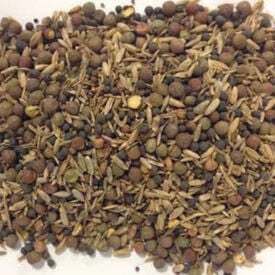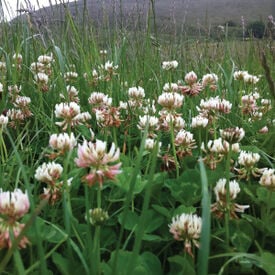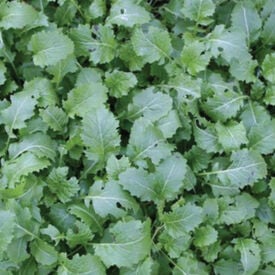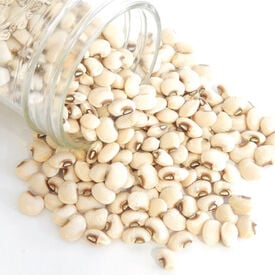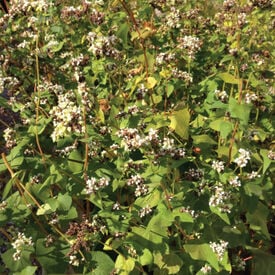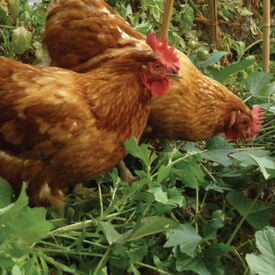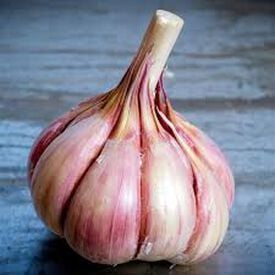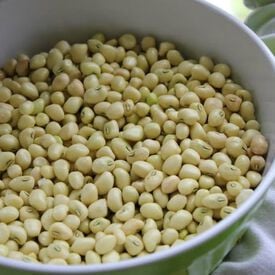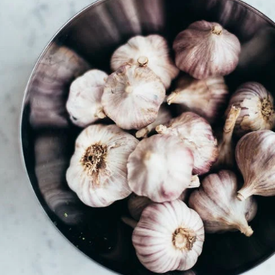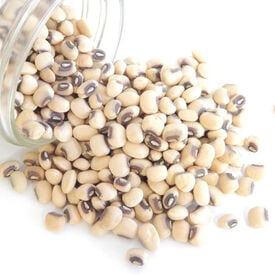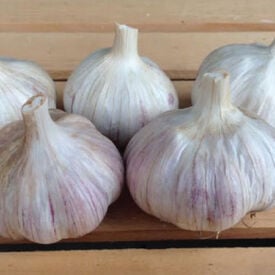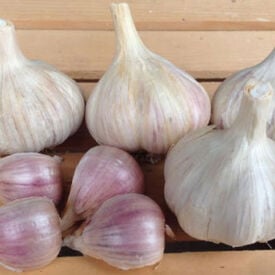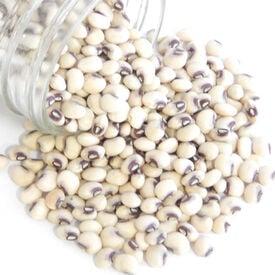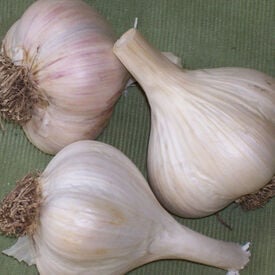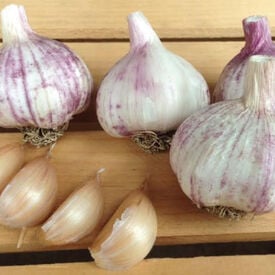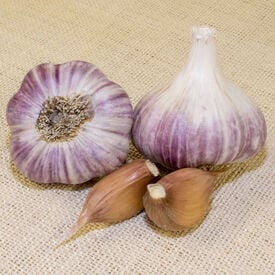A multipurpose cover crop blend that is sowed in fall! This wonderful blend will help with nitrogen fixation, adding organic matter and weed suppression. Contains a blend of Austrian Field Peas, Crimson Clover, Hairy Vetch, Annual and Winter Rye. Cut right after flowering in spring and till into soil for green manure. (30% Field Pea, 20% Crimson Clover, 20% Hairy Vetch, 15% Annual Rye, 15% Winter Rye) Seed Coverage: - 5 lbs covers 2,000-4,000 sqaure feet - 100 lbs covers 1-2 acres Uses: Green Manure, Nitrogen Fixation, No Till, Organic Matter (Biomass), Weed Suppression
The White Dutch Clover is a perennial clover variety that is a customer favorite for controlling erosion while protecting the soil! This legume is a living mulch of permanent cover that spreads by stolons. Grow low so takes close mowing and grazing. The White Dutch Clover benefits bees and insects as well as fixes nitrogen. Uses: Bees & Beneficial Insects, Chicken Forage, Deer Attractant, Erosion Control, Forage, Green Manure, Nitrogen Fixation, No Till, Weed Suppression
Dwarf Essex Rape (Brassica napus) is a fast-growing, cold-hardy forage crop commonly used for livestock grazing, wildlife food plots, and soil improvement. This leafy brassica produces high-protein, highly digestible forage that remains palatable even in colder temperatures, making it an excellent choice for fall and winter grazing. It is drought-resistant and can thrive in various soil types, providing a nutritious food source for deer, cattle, and other grazing animals. Additionally, its deep root system helps improve soil structure and reduce erosion. Due to its rapid regrowth, Dwarf Essex Rape is a valuable option for sustainable pasture management.
The Big Boy Purplehull is a high yielding, popular Southern cowpea that is great for home gardens. Big Boy Purplehull is a long podded variety with 13-16 peas per pod that are light tan in color and oblong shape. This is a good garden variety and is very prolific. If you are using for Nitrogen fixation we highly recommend using a cowpea inoculant. Try with cowpea inoculant for maximum Nitrogen fixation.
California Blackeye #5 is a high yielding, vigorous and easy to grow. You can use these as green shell peas or dry like winter beans. Pods reach 6-8" long and are loaded with creamy, delicious seeds. Does well in high heat areas. Treated Seed.
The Common Buckwheat is a grain that can be planted late spring to early summer and improves top soil and an effective choke weed! This variety establishes quickly and matures in 60 days. This buckwheat accumulates phosphorus and and potassium for following crops and is frost sensitive. Buckwheat (Fagopyrum esculentum Moench): Cool Season, Grain, Annual, Upright growth habit, Enhances soil P availability,Crude protein: straw 5%, grain 13% Uses: Bees & Beneficial Insects, Green Manure, No Till, Organic Matter (Biomass), Weed Suppresion
Growing your own forage for your chickens is a cheap, easy, and a highly nutritious way to feed your chickens. Chicken feed can be expensive to provide throughout the year. Growing your own from spring to fall provides high levels of nutrients that will make your eggs taste even better. Foraging chickens have a better balanced diet that creates better eggs and meat. This chicken forage blend is a mix of well balanced plants that chickens love to eat. Spread at 5 lbs. per 1,000-2,000 square feet. 100 lbs will cover 1 acre. Mixture includes: Annual Ryegrass, Perennial Ryegrass, Buckwheat, Flax, Millet, Forage Peas, Red Clover, Alfalfa
The Persian Star is a hardneck purple stripe type garlic. The outer skin can grow pure white with inner wrappers that are streaked purple. The red-tipped cloves with marbled streaks on whitish or yellow-brown background. The Persian Star is a very pleasant flavor with a mild spicy zing that is a great addition to any dish!
The Zipper Cream cowpeas are very easy to grow and are a tasty Southern favorite! This variety produces bushy 2-3' plants that bear heavy yields. The 6-9" large pods have large, creamy-white seeds. There are 18-20 seeds per pod. The Zipper Cream is an easy to shell cowpea. Treated Seed.
Yugoslavian garlic is considered a porcelain, which is a great storing garlic! This variety is hot & spicy and holds its shape and flavor well when cooked. Yugoslavian is regarded by some as the best if you like a good kick and is a hardneck variety.
The Quickpick Pinkeye cowpea is a bush type southern cowpea with early maturity and good disease resistance. This variety is a pinkeye Purplehull type variety that is determinate, erect, compact (reach about 20 inches), and non-vining. This cowpea gets its name, Quickpick, because it matures in about 60 days. The pods are dark-purple and about seven to eight inches long containing nine to eleven, kidney-shaped seeds with large, maroon colored eyes. If you are using for Nitrogen fixation we highly recommend using a cowpea inoculant. Try with cowpea inoculant for maximum Nitrogen fixation.
The German Red garlic is an easy to grow garlic that is well suited for cold winters. This garlic variety offers a strong, spicy and robust flavor with large, easy to peel cloves. Averages 14 cloves per bulb. Hardneck variety.
Romanian Red garlic produces 4 to 5 large cloves per bulb. This variety's bulbs are a beautiful cream white with shades of purple skins. Once harvested, these whole bulbs will store for months. Romanian Red produces a delicious flavor that is pungent and long-lasting.
Pinkeye Purple Hull cowpea is one of the most popular varieties preferred by Southerners. Cowpeas in general are great for drying and canning. This variety's hulls are purple and its cowpeas are green with pinkeyes when freshly picked turning cream with dark maroon when dried. The Pinkeye Purple Hull produces pods that are six to seven inches long and purple. If you are using for Nitrogen fixation we highly recommend using a cowpea inoculant.
Georgian Crystal garlic has a rich flavor and mild heat for a Porcelain hardneck. When slow roasted this variety, it has an amazing buttery flavor that melts in your mouth! This garlic grows well throughout the USA, but even better in areas with hot summers. Averages 4-5 cloves per bulb.
Georgian Fire garlic is a certified, farm favorite with a stunning flavor and cloves! This garlic variety has the classic garlic porcelain sheen and flavor. The Georgian Fire variety is the beauty queen of the garlic world. Its cloves grow large and average about 6 to 8 per bulb. This garlic can be eaten raw as they have a pleasantly hot flavor. Roasting really brings out the flavor of Georgian Fire! Porcelain hardneck type. Approximately 10 garlic bulbs per pound.
The Siberian garlic is certified and does great in cold weather! Siberian is a mid-season garlic and a great producer in cold climates. This variety does great for all northern gardeners! The cloves of this garlic are protected by an attractive light red skin. This clean, medium-to-strong flavored garlic will warm your soul on the coldest winter evening! Siberian has a very high allicin content, possibly the highest of any garlic. Allicin supports normal cholesterol levels, boosts the immune system, and enhances circulation! Approximately 12 garlic bulbs per pound. Approximately 4-5 cloves per bulb. Hardneck Garlic
Russian Red garlic has big bulbs that have a slightly purple skin that wraps the bulbs and cloves. This variety is a great garlic to grow for soil conditions that are slightly damp. Russian Red is one of the most flavorful heirloom garlics we offer. Approximately 6-9 cloves/ bulb. Approximately 45-60 garlic cloves/ pound.
